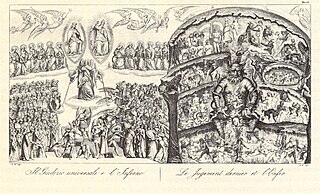
Odorico Politi (Udine, 27 January 1785 - Venice, 18 October 1846) was an Italian painter.

Odorico Politi (Udine, 27 January 1785 - Venice, 18 October 1846) was an Italian painter.
Odorico Politi was born in Udine, and studied in Venice at the Accademia di Belle Arti with Teodoro Matteini. In 1812 he returned to Udine and began a career as a painter of neoclassical frescoes, specializing in historical and mythological subjects. Some of these frescoes can now be seen at the Palazzo Antonini and at Napoleon's Royal Palace in Venice. [1] In 1831 he received an appointment as professor at the Accademia of Venice, where he had studied. Notable students include Pompeo Marino Molmenti, Antonio Dugoni, Fausto Antonioli and Cesare Dell'Acqua. [2]
Politi's frescoes with religious subjects are found in the churches of Attimis, Clauzetto, Felettano, Pavia di Udine, Tarcento, Trieste, Udine, Venice and Vito d'Asio. Selected works include:

Giovanni Battista Tiepolo, also known as GiambattistaTiepolo, was an Italian painter and printmaker from the Republic of Venice who painted in the Rococo style, considered an important member of the 18th-century Venetian school. He was prolific, and worked not only in Italy, but also in Germany and Spain.

Giovanni Battista Piazzetta was an Italian Rococo painter of religious subjects and genre scenes.

The Accademia di Belle Arti di Venezia is a public tertiary academy of art in Venice, Italy.

Carlo Lasinio was an Italian engraver.

Giuseppe Borsato was an Italian painter, primarily of vedute. Known for his work as the architect, decorator, and painter to the French Imperial Court in Venice.

Ettore Tito was an Italian artist particularly known for his paintings of contemporary life and landscapes in Venice and the surrounding region. He trained at the Accademia di Belle Arti in Venice and from 1894 to 1927 was the Professor of Painting there. Tito exhibited widely and was awarded the Grand Prize in painting at the 1915 Panama–Pacific International Exposition in San Francisco. In 1926 he was made a member of the Royal Academy of Italy. Tito was born in Castellammare di Stabia in the province of Naples and died in Venice, the city which was his home for most of his life.

Francesco Pavona was an Italian painter of the Baroque period. He was peripatetic, and became best known throughout Europe for pastel portraits, similar in style to Rosalba Carriera.
Domenico Fossati was born at Venice in 1743, and studied painting at the Accademia di Belle Arti of that city. He distinguished himself as a painter of architecture and a decorator, and his works are to be met with in the theatres and palaces of Venice, Padua, Vicenza, Verona, Udine, Monza, and Gratz, and in the Scala at Milan. He died at Venice in 1785.
Giorgio Matteo Aicardi was an Italian painter, who also specialised in drawings, frescos, restorations and illustrations. He trained at the "Accademia Ligustica di Belle Arti" Genoa Italy, and was part of classic, post impressionist and modernist movements.
Cherubino Cornienti was an Italian painter, active in a Romantic style mainly in Northern Italy.
Luigi Boscolo was an Italian engraver, active in Venice.

Vincenzo Volpe was an Italian painter. From 1874 to 1890, he painted mostly genre scenes. From 1891 to 1896, he concentrated on religious art, then returned to genre works and portraits.
Salvatore Postiglione was an Italian painter, mainly of portraits, and historic and genre subjects, in a Realist style.
Ulisse Ribustini was an Italian painter, mainly of conventional sacred subjects and genre subjects. He also painted large decorative murals at Ponte della Pietra, at the chapter house of the Cathedral of Perugia, at the parish church of Ferretto, near Castiglione del Lago, and at Gualdo Tadino Cathedral. As a young man he painted the frescoes depicting the Story of the Aeneid for the Sala Consiliare di Civitanova Marche. he also made over 100 illustrations based on Dante's Divine Comedy.

Pompeo Marino Molmenti was an Italian painter.

Cosroe Dusi was an Italian painter in the Neoclassical style, active for many years in St Petersburg, Russia, painting mainly sacred and historical subjects. Dusi was nicknamed by his contemporaries the "modern Tintoretto", for his liveliness of invention and rapidity at painting.

Antonio Dugoni was an Italian painter.
Giovanni Andrea Darif (1801–1870) was an Italian painter, mainly of religious subjects and portraits in a Neoclassical style. He was active in Udine, Milan and the Comasco.
Dino Aldo Basaldella was an Italian sculptor and painter.
Mirko Basaldella was an Italian sculptor and painter.